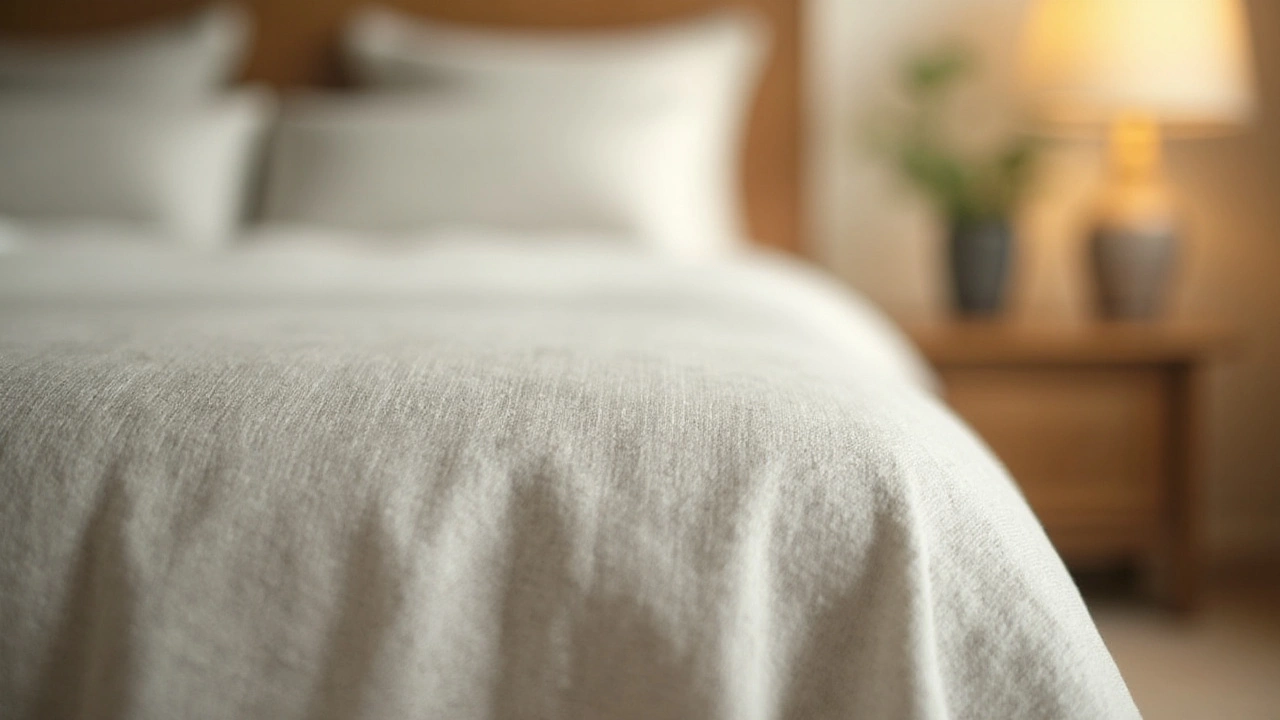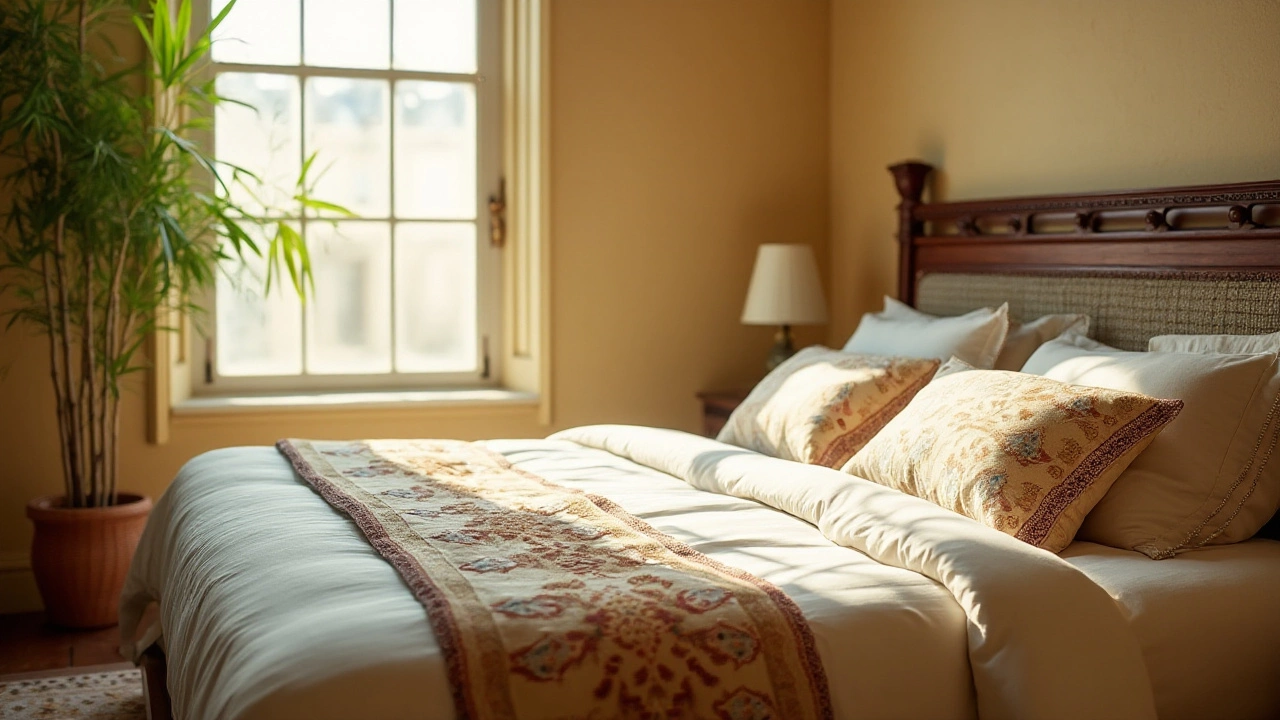Choosing the right bedding can feel like a daunting task, especially when you want something that not only feels good but lasts long too. With so many materials available, understanding which ones stand the test of time is crucial for making a worthwhile investment in your comfort.
This guide dives into the world of bedding materials, focusing on those praised for their durability. From the crisp comfort of cotton to the elegant resilience of linen, knowing what each material offers can help you make an informed choice. We also explore how the weave and thread count play roles in the lifespan of your bedding, and offer practical tips for maintaining these cozy companions. Let's uncover what keeps you snug for years to come.
- Understanding Bedding Materials
- Natural Fibers: Cotton, Linen, and Bamboo
- Synthetic Options: Polyester and Microfiber
- The Role of Weave and Thread Count
- Maintaining and Caring for Your Bedding
Understanding Bedding Materials
When it comes to selecting the perfect bedding, the material plays a pivotal role. It's not just about the initial feel against your skin but also how well it holds up over time. Different materials bring distinct characteristics to your sleep experience. Natural fibers like cotton, linen, and bamboo boast incredible durability and breathe well, providing comfort and longevity. Cotton, a popular choice, varies widely depending on its weave and quality—including Egyptian and Pima cotton, known for their superior fibers which ensure that the bedding not only feels luxurious but wears very well with time.
Synthetic materials have their place too, with polyester being a common inclusion in many blends due to its affordability and resilience. These materials often resist wrinkles and shrinkage, which makes them user-friendly for those who prefer low-maintenance care routines. Blends of polyester and cotton strike a balance between the two worlds, offering a combo of durability and comfort at a reasonable price point.
Understanding the intricacies of these materials can help guide your decision. For instance, linen is much-loved for its ability to keep you cool in summer and warm in winter. Its fibers are stronger than cotton, meaning it can often last years as it softens beautifully over time.
"Linen becomes more supple with each wash—a unique trait not shared by many other materials," notes interior designer and textile expert, Emily Berns.Knowing these subtleties will aid in finding bedding that suits not only your immediate comfort but also your long-term expectations of wear.
Not to be overlooked is the influence of evolving technology in textile manufacturing, enhancing lifespan and comfort. For example, some modern bedding incorporates moisture-wicking features or antimicrobial properties, combining natural fibers with cutting-edge processes to create products that meet specific sleep needs. This harmony of classic materials and modern innovations can deliver bedding that supports quality sleep while lasting through numerous cycles of use and wash.
Natural Fibers: Cotton, Linen, and Bamboo
Cotton is a perennial favorite in the world of bedding, celebrated for its softness, breathability, and versatility. Known for its long fibers, Egyptian cotton ranks among the finest with its durable, silky touch. Staple varieties like Supima and Pima cotton offer similar longevity and comfort. The weave significantly impacts durability; for instance, percale is crisp and cool, whereas sateen provides a smooth sheen. Both weaves, if manufactured with high-quality standards, can remain resilient after numerous washes, standing guard against wear and tear. For those keen on sustainable options, organic cotton emerges as an alternative, merging eco-friendly practices with the reliability that cotton lovers cherish.
Linen holds its place as a durable natural fiber, unmatched in its characteristic texture and cooling properties. Linen sheets may feel a bit weightier at first touch, but they soften gracefully over time, gaining appeal with each use. What sets linen apart is its resilience against pilling, a common issue with other fabrics. Its moisture-wicking capabilities make it perfect for hot climates, where comfort meets functionality. Though initially pricey, linen’s long lifespan justifies the expense, making it a worthy investment for the sustainability-conscious consumer.
Bamboo is a less traditional but increasingly popular choice in the realm of durable bedding. Known for its environmental benefits, bamboo grows swiftly without extensive resources. This translates into sheets that are both eco-friendly and practical. The fibers produced from bamboo possess a unique silk-like texture, combining softness with durability. Despite their delicacy at first touch, bamboo sheets are surprisingly sturdy, retaining their integrity through wash cycles without fading or tearing. They also bring hypoallergenic qualities to the table, offering a boon for allergy sufferers seeking comfort in their materials.
"The beauty of natural fibers like cotton, linen, and bamboo lies not just in their tactile pleasures but in their durability, an aspect often overlooked until experienced firsthand," remarks textile expert Lorelei Mason.
A comparative aspect to note is the breathability offered by these natural fibers, each excelling in regulating temperature to enhance sleep quality. Cotton and linen shine in moisture absorption, while bamboo takes the lead in airflow, providing continuous comfort throughout the night. These attributes make them the go-to choices for individuals prioritizing both comfort and endurance. When selecting your next set of bedding materials, considering the unique benefits of cotton, linen, and bamboo can lead to a satisfying, long-lasting sleep sanctuary.

Synthetic Options: Polyester and Microfiber
When it comes to bedding that offers both durability and versatility, synthetic materials like polyester and microfiber present compelling choices. While natural fibers have their own allure, these man-made fabrics come with a unique set of advantages that can be particularly appealing to those seeking both performance and affordability. Polyester, a strong and resilient fiber, is known for its ability to withstand extensive use. It's often blended with other materials to enhance durability and reduce cost, making it a popular choice for those shopping on a budget.
One of the key benefits of polyester is its wrinkle resistance. Unlike cotton, which often requires ironing, polyester sheets typically emerge from the dryer smooth and ready to use. This low-maintenance aspect can save time and effort, appealing to busy households. Additionally, microfiber, a type of polyester woven to create a soft and plush texture, is known for its densely packed fibers which create a strong, durable fabric. Despite being lightweight, microfiber bedding offers exceptional warmth, making it a great choice during colder months.
In terms of color retention, both polyester and microfiber excel where natural fibers may fade over time. These synthetic materials can hold dyes much better, allowing for vibrant, long-lasting colors. This is particularly advantageous for those interested in bold bedding designs. While these attributes are appealing, it's also important to consider the breathability and environmental impact of synthetic options. Although advancements have made these fabrics more breathable, they may still trap heat compared to cotton or linen. As for their environmental footprint, polyester and microfiber are not biodegradable, which might be a concern for eco-conscious consumers.
"Polyester blends remain a popular choice in the bedding market due to their advantageous price point and resilience," says Emma Sherman, a leading textile expert. "Although not as breathable as natural fibers, modern polyester fabrics offer a balance of comfort and longevity ideal for many homes."
For those looking to balance the convenience and durability of synthetic fabrics with their potential downsides, it's helpful to regularly rotate bedding and follow specific care instructions to extend their lifespan. Washing at cooler temperatures and avoiding harsh detergents can prevent fiber degradation. Cleaning routines should be tailored to protect the integrity of the synthetic fibers, further promoting their long-lasting nature and keeping them looking fresh and vibrant in your bedroom.
The Role of Weave and Thread Count
When it comes to bedding, the weave and thread count play critical roles in determining its durability and comfort. While many are often tempted by the lure of a high thread count, thinking it equates to better quality, it is essential to understand that it's not the singular factor to consider. The type of weave significantly influences how a fabric feels, behaves, and lasts over time.
The two most common weaves in bedding are percale and sateen. Percale weave is tightly woven, often associated with a crisp, matte finish and a cool touch perfect for summer nights. It’s known for its strength and structural soundness, which contributes to its longevity. On the other hand, sateen weave, with its lustrous and smooth texture, offers a silk-like feel, ideal for those cozying up during chilly months. Despite its luxurious feel, the weave is less resistant to pilling compared to percale, possibly compromising durability.
Thread count, the number of threads woven into a square inch of fabric, does impact the softness and texture of the bedding. However, simply opting for a higher thread count—anything above 800—might not always guarantee better bedding. High thread counts can result from thinner threads being twisted together, potentially affecting the breathability and strength of the fabric. Many experts advise aiming for a good range, typically between 200 to 800, for a balance of softness and durability.
Understanding Fabric Longevity
In terms of fabric strength, it's not just about quantity, but quality of the threads used, which contributes significantly to how long your bedding lasts. Long-staple fibers, like those in Egyptian or Pima cotton, tend to fare better when woven and washed over the years. They create less friction and better withstand frequent laundry cycles.
One curious notion is that industrial manipulation of fibers can lead to amplified wear. As some manufacturers blend materials to achieve extraordinary thread counts, this may inadvertently compromise the integrity of the bedding, making it prone to easy wear and tear. A noteworthy suggestion from industry professionals is prioritizing the source and processing of the cotton, rather than relying solely on the numbers.
“Bedding is a staple of comfort, but understanding its composition helps prolong its life—just like understanding fine art enhances our appreciation”
Ultimately, the weave and thread count, paired with the innate quality of the fibers, come together to determine the lifespan of your bedding. When selecting the right sheet set, these are critical parameters to consider ensuring your investment serves you the warmth and comfort you need for years of restful nights.

Maintaining and Caring for Your Bedding
To ensure that your bedding retains its durability and remains a comfortable sanctuary, proper care and maintenance are essential. The longevity and sustained quality of materials like cotton, linen, and bamboo largely depend on how they are washed and stored. It's important to follow the washing instructions provided by manufacturers as they are tailored to maximize the lifespan of the fabric. For instance, cotton bedding generally fares well when washed in warm water with mild detergent. However, to preserve its color and prevent damage, it is sometimes best to opt for cold water instead. Drying on a low heat setting or air drying can extend the life of the fibers by preventing shrinkage and damage.
Using the right detergent is crucial for maintaining your bedding's integrity. Hypoallergenic detergents without harsh chemicals are ideal, as they are less likely to break down natural fibers or cause skin irritation. Adding vinegar during the rinse cycle can help remove residues that might dull fabrics without causing any damage. Additionally, rotating your bedding regularly can reduce wear and tear in specific areas, maintaining a uniform look and feel across the bed. It also gives each set of sheets a break, which helps them last longer by reducing the frequency of washing cycles.
Linen and Bamboo Specific Care
Linen and bamboo, known for their breathability and moisture-wicking properties, require special consideration to maintain their textures. Linen should be washed on a gentle cycle and it's wise to avoid overdrying as this can make the fabric harsh. Try removing it from the dryer while still damp and air drying to have softer results. Bamboo bedding should be treated similarly, as both share the natural tendency to wrinkle and are delicate. Even if bamboo sheets can usually withstand washing machines, consider the air-drying method as it ensures the longevity of this precious material, maintaining its luxurious softness and delicate sheen.
"Proper fabric care can extend a product's life by several years," notes textile expert Linda Lane. This highlights the impact a little extra care can truly have on your bedding's lifespan.
Storing your bedding correctly also plays a vital role in its maintenance. Store clean, purely dried bedding in a cool, dry place, ideally in a linen closet where it won't be exposed to direct sunlight. This prevents any potential fading and fabric damage that can be caused over time. Avoid using plastic storage bags as they trap moisture which can lead to mold and mildew growth. Instead, use breathable cotton storage sacks or baskets, which allow air circulation and maintain the natural scents and quality of your linens. As you carefully maintain your bedding, you not only uphold its appearance and comfort but also its durability, ensuring each night is swathed in lasting luxury.
